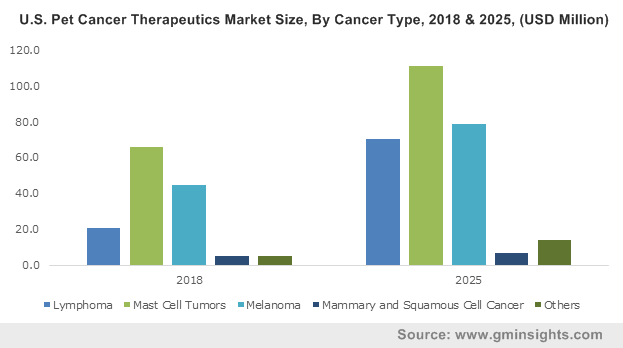Chemotherapy drugs to fuel pet cancer therapeutics market growth over 2017-2024, with North America being a major revenue pocket
Publisher : Fractovia | Published Date : 2017-08-24Request Sample
The rising trend of pet owners wanting to extend the life quality of pets through therapeutic modalities will spur pet cancer therapeutics market revenue. As per the estimates by NIH (National Institute of Health), nearly 6 million dogs and cats in the U.S. are said to be diagnosed with cancer. This offers a lucrative opportunity for the medical fraternity to study the correlation between the cancers occurring in human beings and animals, thereby helping medical experts unearth novel cancer treatment methodologies, which will gradually impact pet cancer therapeutics industry share. The most common type of cancers occurring both in pet animals such as cats and dogs as well as in humans includes lung carcinoma, breast cancer, non-Hodgkin’s lymphoma, melanoma, prostate carcinoma, virally induced lymphoma, head & neck carcinoma, osteosarcoma, soft tissue sarcoma, and mammary carcinoma. A comparative study of cancer occurrence in dogs and human beings is expected to improve the understanding of cancer in the ensuing years, eventually opening new avenues for pet cancer therapeutics market players.
U.S Pet cancer therapeutics market, by medicine type, 2013 - 2024 (USD Million)

Companies in pet cancer therapeutics market have been working toward launching new drugs for cancer treatments to increase the survival rates in the animals. The newly developed UMN drug referred as eBAT was successfully tested on 23 dogs of different breeds at the University of Minnesota, the outcome of which indicated a rise in the survival rates of dogs affected from Hemangiosarcoma (HSA) cancer. During the trials, canines were injected with eBAT thrice before chemotherapy and after performing surgeries for tumor removal. The therapy raised the survival rate of the pet animals to 70% - a factor which may cause pet cancer therapeutics market players to sit up and explore potential growth opportunities. Besides, five of the 23 dogs, who were treated with eBAT, survived for over 450 days. HSA being a blood vessel based cancer type, necessitated the use of the UMN drug for the clinical test, as it can target both, the vascular system and cancer tumor.
Dating back to 2014, Advaxis, a biotechnology and healthcare firm based in the U.S., had discovered a drug called ADXS-cHER2 and successfully treated the 18 dogs affected from osteosarcoma at the Pennsylvania School of Veterinary Medicine. During the clinical tests, 9 out of 18 dogs depicted positive immunological responses. It was later discovered that more than two-third of the dogs who were treated with the drug survived for a prolonged period. These drug trials depict that new inventions in the field of pet cancer technology are certain to augment pet cancer therapeutics market share.
Speaking of another novel collaboration in pet cancer therapeutics industry, in December 2015, Spotlight Innovation Incorporation, had formed a subsidiary firm named as CDT Veterinary Therapeutics Incorporation to detect new cancer treatment methods in pets. The latter had emphasized on the commercialization of Crotalin, a drug comprising cytotoxic proteins, endowed with the ability to eliminate animal cancer cells. The move offers more opportunities for other key business players to explore various dimensions of cancer treatment, thereby providing a positive impetus to pet cancer therapeutics industry. As per Global Market Insights, Inc., pet cancer therapeutics industry is slated to produce a revenue of more than USD 300 million by 2024, growing at a rate of over 10% over 2017-2024.
Strategic alliances and joint ventures are the prime growth strategies of pet cancer therapeutic industry. In 2016, Aratana Therapeutics Incorporation, a U.S. based pharmaceutical firm, had entered an alliance with Elanco, a division of Eli Lilly & Company. According to the strategic agreement, the latter was provided with the rights to expand its pet animal product portfolio across the U.S.
Highlights of the key topographical trends influencing pet cancer therapeutics market:
- Growing awareness about pet health along with the presence of many pet cancer medicine manufacturers in countries such as the U.S., is likely to provide a positive impetus to pet cancer therapeutics market expansion across North America, that contribute to over 80% of the overall industry revenue in 2016.
- Increasing accessibility of pet cancer vaccines across Europe coupled with extensive cancer research across countries such as the UK will ramp up the pet cancer therapeutics market development across Europe.
- India pet cancer therapeutics industry is projected to experience tremendous progress over the coming years, recording a CAGR of more than 12% over 2017-2024. Rise in pet healthcare funding along with easy availability of cancer drugs for pets are forecast to spur this business space.
It has been observed that renowned pharmaceutical and biotech firms have been continuously striving to create awareness about pet cancer treatments, pertaining to which they have been investing heavily in cancer research programs to develop new drugs. Some of renowned players such as Aratana Therapeutics Incorporation, Zoetis Incorporation, AB Science, Karyopharm Therapeutics and VetDChave, having a global presence, are expected to contribute majorly toward pet cancer therapeutics market share.